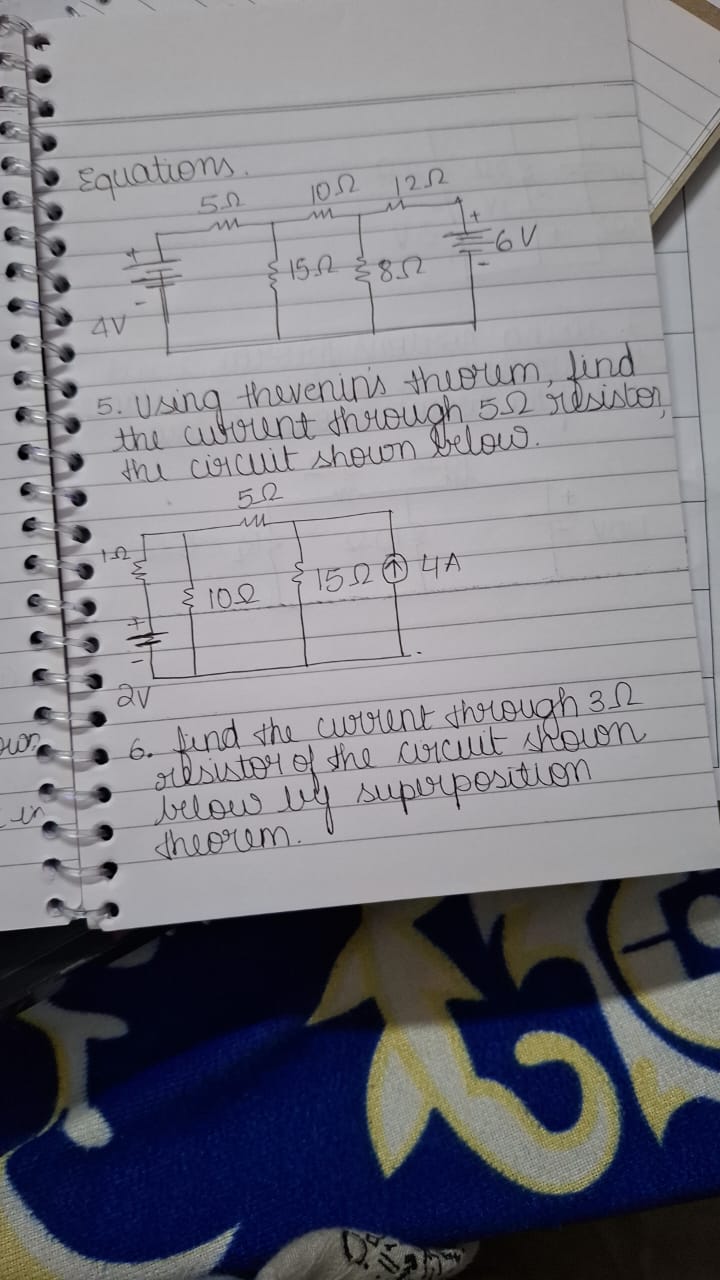Using Thevenin's theorem, find the current through the 5Ω resistor in the circuit shown below. Find the current through the 3Ω resistor of the circuit shown below by superposition... Using Thevenin's theorem, find the current through the 5Ω resistor in the circuit shown below. Find the current through the 3Ω resistor of the circuit shown below by superposition theorem.

Understand the Problem
The question is asking us to use Thevenin's theorem to find the current through a specific resistor in a given circuit diagram. Additionally, it asks for the application of the superposition theorem to find the current through another resistor.
Answer
The current through the $5 \, \Omega$ resistor is $I_{5\Omega} = \frac{V_{th}}{R_{th} + 5}$ and the current through the $3 \, \Omega$ resistor is $I_{3\Omega} = I_1 + I_2$.
Answer for screen readers
The current through the $5 , \Omega$ resistor is $I_{5\Omega} = \frac{V_{th}}{R_{th} + 5}$.
The current through the $3 , \Omega$ resistor, based on superposition, is $I_{3\Omega} = I_1 + I_2$ where $I_1$ and $I_2$ are contributions from each source.
Steps to Solve
-
Identify the components in the circuit using Thevenin's theorem
Focus on the circuit containing the $5 , \Omega$ resistor. The goal is to find the equivalent Thevenin circuit across this resistor. Identify and label all resistors and voltage sources in the circuit.
-
Remove the $5 , \Omega$ resistor
Temporarily remove the $5 , \Omega$ resistor from the circuit to analyze the remaining portion.
-
Find Thevenin voltage ($V_{th}$)
To find $V_{th}$, calculate the voltage across the terminals where the $5 , \Omega$ resistor was connected. You can use voltage division or mesh analysis.
For example, if using voltage division: $$ V_{th} = V_s \cdot \frac{R_x}{R_x + R_{total}} $$ where $V_s$ is the source voltage and $R_x$ is the resistor connected in series with the voltage source.
-
Find Thevenin resistance ($R_{th}$)
To find $R_{th}$, short the voltage sources and calculate the equivalent resistance seen from the terminals.
$$ R_{th} = R_{1} || R_{2} || ... $$ where $||$ indicates the parallel combination of resistances.
-
Reinsert the $5 , \Omega$ resistor in Thevenin equivalent circuit
Reconnect the $5 , \Omega$ resistor to the Thevenin equivalent circuit composed of $V_{th}$ and $R_{th}$.
-
Find the current through the $5 , \Omega$ resistor
Use Ohm’s law to find the current flowing through the $5 , \Omega$ resistor: $$ I = \frac{V_{th}}{R_{th} + 5 , \Omega} $$
-
Apply superposition theorem for the current through the $3 , \Omega$ resistor
Redraw the circuit, solving for the current through the $3 , \Omega$ resistor. Consider the contributions from each source independently by shorting independent voltage sources and opening independent current sources.
-
Calculate the total current through the $3 , \Omega$ resistor
Combine the currents calculated from each source (from the previous step) to find the total current through the $3 , \Omega$ resistor.
The current through the $5 , \Omega$ resistor is $I_{5\Omega} = \frac{V_{th}}{R_{th} + 5}$.
The current through the $3 , \Omega$ resistor, based on superposition, is $I_{3\Omega} = I_1 + I_2$ where $I_1$ and $I_2$ are contributions from each source.
More Information
Thevenin's theorem simplifies complex circuits into a single voltage source and series resistance, making it easier to analyze circuits with multiple components. The superposition theorem allows for the analysis of circuits with multiple sources by examining one source at a time.
Tips
- Forgetting to remove the load resistor when finding Thevenin equivalent.
- Miscalculating the total resistance in Thevenin resistance calculation.
- Neglecting the polarity of voltage sources when applying superposition.
AI-generated content may contain errors. Please verify critical information